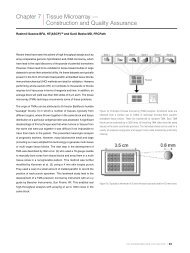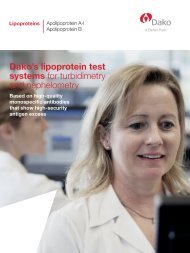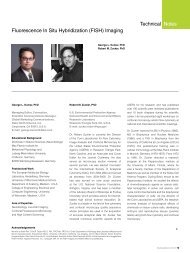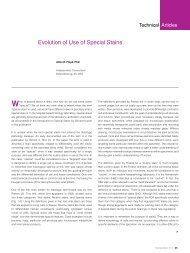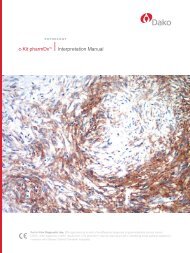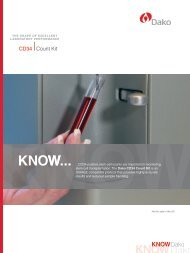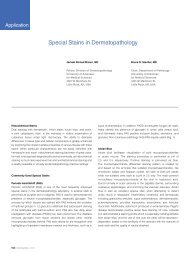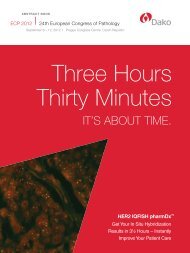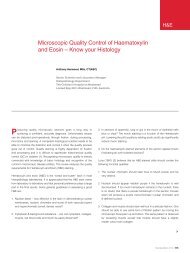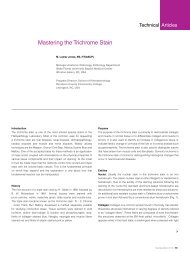HER2/neu Status is an Important Biomarker in Guiding ... - Dako
HER2/neu Status is an Important Biomarker in Guiding ... - Dako
HER2/neu Status is an Important Biomarker in Guiding ... - Dako
You also want an ePaper? Increase the reach of your titles
YUMPU automatically turns print PDFs into web optimized ePapers that Google loves.
<strong>HER2</strong>/<strong>neu</strong> <strong>Status</strong> <strong>is</strong> <strong>an</strong> Import<strong>an</strong>t <strong>Biomarker</strong><strong>in</strong> Guid<strong>in</strong>g Personalized <strong>HER2</strong>/<strong>neu</strong> TherapyWalter P. Carney, PhDHead, Oncogene Science, Bayer HealthCareCambridge, MassachusettsAn import<strong>an</strong>t member of the oncogenefamily <strong>is</strong> the growth factor receptor knownas the Hum<strong>an</strong> Epidermal Growth FactorReceptor-2 (<strong>HER2</strong>), which <strong>is</strong> also referredto as <strong>HER2</strong>/<strong>neu</strong> or c-erbB-2. The full-lengthglycoprote<strong>in</strong> has a molecular weight of185,000 daltons (p185) <strong>an</strong>d <strong>is</strong> composed ofthe <strong>in</strong>ternal tyros<strong>in</strong>e k<strong>in</strong>ase doma<strong>in</strong>, a shorttr<strong>an</strong>smembr<strong>an</strong>e portion <strong>an</strong>d <strong>an</strong> extracellulardoma<strong>in</strong> (ECD). The extracellular portion ofthe receptor prote<strong>in</strong> has a molecular weight<strong>in</strong> the 97-115 kDa r<strong>an</strong>ge <strong>an</strong>d has beenshown to be circulat<strong>in</strong>g <strong>in</strong> the serum orplasma of normal <strong>in</strong>dividuals <strong>an</strong>d to beelevated <strong>in</strong> the circulation of patients withbreast c<strong>an</strong>cer. 1,2,3,4Over the last several years the <strong>HER2</strong>/<strong>neu</strong>oncoprote<strong>in</strong> has emerged as <strong>an</strong> import<strong>an</strong>tcellular target for the development of avariety of new c<strong>an</strong>cer therapies. The methodused to def<strong>in</strong>e the <strong>HER2</strong>/<strong>neu</strong> status <strong>is</strong> amajor factor <strong>in</strong> determ<strong>in</strong><strong>in</strong>g who will receivethese targeted therapies. The <strong>HER2</strong>/<strong>neu</strong>status c<strong>an</strong> be determ<strong>in</strong>ed by either us<strong>in</strong>gt<strong>is</strong>sue tests or <strong>an</strong> ELISA that measuresthe circulat<strong>in</strong>g levels of serum <strong>HER2</strong>/<strong>neu</strong>.T<strong>is</strong>sue test results <strong>in</strong>dicate that approximately20-30 percent of patients with primarybreast c<strong>an</strong>cer have a <strong>HER2</strong>/<strong>neu</strong> positivetumor whereas ELISA test results <strong>in</strong>dicatethat approximately 45 percent (r<strong>an</strong>ge= 23-80 percent) of metastatic breast c<strong>an</strong>cer(MBC) patients have <strong>HER2</strong>/<strong>neu</strong> positivity,as determ<strong>in</strong>ed by <strong>an</strong> elevated serum<strong>HER2</strong>/<strong>neu</strong> test.Publ<strong>is</strong>hed studies show that the <strong>HER2</strong>/<strong>neu</strong>status of a breast c<strong>an</strong>cer patient c<strong>an</strong> differbased on the test methods used <strong>an</strong>d the timeof <strong>HER2</strong>/<strong>neu</strong> assessment. In th<strong>is</strong> report, it willbe shown that not all <strong>HER2</strong>/<strong>neu</strong> test resultsobta<strong>in</strong>ed from the primary breast c<strong>an</strong>cer arecorrect <strong>an</strong>d that there <strong>is</strong> a population of patientsdesignated as <strong>HER2</strong>/<strong>neu</strong> negative by t<strong>is</strong>suetests that, <strong>in</strong> fact, have <strong>HER2</strong>/<strong>neu</strong> positivetumors by serum test<strong>in</strong>g. Th<strong>is</strong> observationhas import<strong>an</strong>t therapeutic implications forbreast c<strong>an</strong>cer patients with <strong>HER2</strong>/<strong>neu</strong> positivetumors who are not currently eligible for <strong>an</strong>ti-<strong>HER2</strong>/<strong>neu</strong> therapy. In the specific case ofdeterm<strong>in</strong><strong>in</strong>g <strong>HER2</strong>/<strong>neu</strong> status, it will takemultiple types of <strong>HER2</strong>/<strong>neu</strong> tests applied atdifferent times to identify patients with <strong>HER2</strong>/<strong>neu</strong> positive breast tumors.Serum <strong>HER2</strong>/<strong>neu</strong> Levels <strong>an</strong>d Cl<strong>in</strong>ical <strong>Status</strong> - 93 weeksTh<strong>is</strong> figure illustrates the ch<strong>an</strong>ges <strong>in</strong> serum <strong>HER2</strong>/<strong>neu</strong> levels over a 93 week period, <strong>in</strong> a metastatic breastc<strong>an</strong>cer (MBC) patient receiv<strong>in</strong>g Hercept<strong>in</strong>-based therapy. The ch<strong>an</strong>ges <strong>in</strong> serum <strong>HER2</strong>/<strong>neu</strong> levels parallelthe cl<strong>in</strong>ical course of d<strong>is</strong>ease. Resp = Response, NED = No Evidence of d<strong>is</strong>ease, Prog = Progression.Methods of establ<strong>is</strong>h<strong>in</strong>g the<strong>HER2</strong>/<strong>neu</strong> status of a breastcarc<strong>in</strong>omaCurrently, there are two t<strong>is</strong>sue tests that areFDA approved to establ<strong>is</strong>h the <strong>HER2</strong>/<strong>neu</strong>status of a patient with breast c<strong>an</strong>cer <strong>an</strong>done test cleared by the FDA for monitor<strong>in</strong>gch<strong>an</strong>g<strong>in</strong>g serum levels of <strong>HER2</strong>/<strong>neu</strong> <strong>in</strong>patients with MBC. All three tests c<strong>an</strong> identifypatients with <strong>HER2</strong>/<strong>neu</strong> positive tumors butonly the two t<strong>is</strong>sue tests are approved forselect<strong>in</strong>g patients for <strong>an</strong>ti-<strong>HER2</strong>/<strong>neu</strong> therapy.The t<strong>is</strong>sue tests are immunoh<strong>is</strong>tochem<strong>is</strong>try(IHC) <strong>an</strong>d Fluorescence In Situ Hybridization(FISH). 5 Both tests are performed on formal<strong>in</strong>fixedparaff<strong>in</strong> embedded material obta<strong>in</strong>ed atthe time of diagnos<strong>is</strong> of primary breast c<strong>an</strong>cer<strong>an</strong>d require evaluation by a patholog<strong>is</strong>t.The third test, a Serum <strong>HER2</strong>/<strong>neu</strong> ELISA(m<strong>an</strong>ufactured by Oncogene Science/BayerHealthCare <strong>an</strong>d d<strong>is</strong>tributed by <strong>Dako</strong>) <strong>is</strong>able to reproducibly measure levels of thecirculat<strong>in</strong>g shed extracellular doma<strong>in</strong> ofthe <strong>HER2</strong>/<strong>neu</strong> oncoprote<strong>in</strong> <strong>in</strong> the serum ofmetastatic breast c<strong>an</strong>cer patients. The testfor measur<strong>in</strong>g serum <strong>HER2</strong>/<strong>neu</strong> has beencleared by the FDA for the m<strong>an</strong>agement <strong>an</strong>dmonitor<strong>in</strong>g of patients with MBC who have<strong>an</strong> <strong>in</strong>itial serum <strong>HER2</strong>/<strong>neu</strong> value above thenormal cut off of 15 ng/mL. 4There have been numerous publicationsthat show a strong correlation between serialch<strong>an</strong>ges <strong>in</strong> serum <strong>HER2</strong>/<strong>neu</strong> levels <strong>an</strong>d thecl<strong>in</strong>ical course of patient’s metastatic breastc<strong>an</strong>cer, regardless of their treatment regimen.The majority of these reports have shownthat serum <strong>HER2</strong>/<strong>neu</strong> levels parallel thecl<strong>in</strong>ical course of d<strong>is</strong>ease, with <strong>in</strong>creas<strong>in</strong>glevels be<strong>in</strong>g associated with progressived<strong>is</strong>ease <strong>an</strong>d decreas<strong>in</strong>g levels be<strong>in</strong>gassociated with response to therapy. Theoverall correlation between cl<strong>in</strong>ical courseof d<strong>is</strong>ease <strong>an</strong>d serial ch<strong>an</strong>ges <strong>in</strong> the circulat<strong>in</strong>gserum <strong>HER2</strong>/<strong>neu</strong> <strong>is</strong> approximately86 percent. 6 Some reports 7 have <strong>in</strong>dicatedthat serial ch<strong>an</strong>ges <strong>in</strong> circulat<strong>in</strong>g <strong>HER2</strong>/<strong>neu</strong>ÑConnection 9 2006 | 25
Optimize patient care us<strong>in</strong>g HercepTest ® <strong>an</strong>dSerum <strong>HER2</strong>/<strong>neu</strong> <strong>in</strong> Breast C<strong>an</strong>cer M<strong>an</strong>agement.levels may even precede the actual cl<strong>in</strong>icalsigns of progressive d<strong>is</strong>ease by severalmonths, however, th<strong>is</strong> observation needsadditional confirmation.It <strong>is</strong> also <strong>in</strong>terest<strong>in</strong>g to note that severalrecent publications have suggested that thedegree of decrease <strong>in</strong> serum <strong>HER2</strong>/<strong>neu</strong> afterHercept<strong>in</strong>-based therapy may be stronglyassociated with a favorable patient outcomeas measured by progression-free survival. 8–10The frequency of <strong>HER2</strong>/<strong>neu</strong> positivebreast c<strong>an</strong>cersNumerous reports measur<strong>in</strong>g serum <strong>HER2</strong>/<strong>neu</strong> have suggested that the frequency of<strong>HER2</strong>/<strong>neu</strong> positive tumors could be greaterth<strong>an</strong> the 20–30 percent reported with t<strong>is</strong>suetests. 5 To better underst<strong>an</strong>d the frequency of<strong>HER2</strong>/<strong>neu</strong> positive tumors <strong>in</strong> breast c<strong>an</strong>cerpatients, we conducted a comprehensivesystematic review of publications thatreported elevated levels of the serum<strong>HER2</strong>/<strong>neu</strong> <strong>in</strong> breast c<strong>an</strong>cer patients. Weidentified a total of 60 publ<strong>is</strong>hed studies,represent<strong>in</strong>g 7,639 breast c<strong>an</strong>cer patients.Upon review of 25 studies represent<strong>in</strong>g 2,623patients with primary c<strong>an</strong>cer, we found thatapproximately 18.1 percent (r<strong>an</strong>ge of 0-38percent) of patients had <strong>an</strong> elevated serum<strong>HER2</strong>/<strong>neu</strong> level. We also reviewed 50 studiesrepresent<strong>in</strong>g 5,044 patients with MBC; <strong>in</strong> th<strong>is</strong><strong>an</strong>alys<strong>is</strong> we found that the average percentof MBC patients with <strong>an</strong> elevated serum<strong>HER2</strong>/<strong>neu</strong> level was 45.6 percent (r<strong>an</strong>ge 23-80 percent). In 20 of the 50 publications (40percent), it was po<strong>in</strong>ted out that 50 percent ormore of the MBC patients had elevated serum<strong>HER2</strong>/<strong>neu</strong> levels (reviewed <strong>in</strong> 11 & 12).Th<strong>is</strong> <strong>in</strong>formation <strong>is</strong> <strong>in</strong> sharp contrastto the m<strong>an</strong>y publications s<strong>in</strong>ce the mid-1980’s that report only 20-30 percent ofpatients with breast c<strong>an</strong>cer overexpressthe <strong>HER2</strong>/<strong>neu</strong> oncoprote<strong>in</strong> <strong>in</strong> the primarytumor t<strong>is</strong>sue by IHC or FISH. Collectively,the publications cit<strong>in</strong>g measurement ofserum <strong>HER2</strong>/<strong>neu</strong> showed that the frequencyof <strong>HER2</strong>/<strong>neu</strong> positive tumors <strong>in</strong> at leastmetastatic breast c<strong>an</strong>cer patients <strong>is</strong> greaterth<strong>an</strong> generally known <strong>an</strong>d much greaterth<strong>an</strong> 20-30 percent reported us<strong>in</strong>g t<strong>is</strong>suetests. Th<strong>is</strong> fact has import<strong>an</strong>t therapeuticimplications for breast c<strong>an</strong>cer patients with<strong>HER2</strong>/<strong>neu</strong> positive tumors <strong>an</strong>d demonstratesthe import<strong>an</strong>ce of clearly establ<strong>is</strong>h<strong>in</strong>g thecorrect <strong>HER2</strong>/<strong>neu</strong> status of the breast tumor.C<strong>an</strong> some breast c<strong>an</strong>cer patients whoare designated <strong>HER2</strong>/<strong>neu</strong> negative,have <strong>HER2</strong>/<strong>neu</strong> positive tumors?Given that the prevalence of <strong>HER2</strong>/<strong>neu</strong>positive tumors by ELISA test<strong>in</strong>g <strong>is</strong> muchgreater th<strong>an</strong> the 20–30 percent, <strong>an</strong> obviousquestion to ask <strong>is</strong> whether <strong>HER2</strong>/<strong>neu</strong> negativepatients are really <strong>HER2</strong>/<strong>neu</strong> negative.The <strong>an</strong>swer to such a question could haveserious therapeutic implications for womenwith MBC. To <strong>in</strong>vestigate th<strong>is</strong> question,we searched the literature <strong>an</strong>d foundnumerous publications (reviewed <strong>in</strong> 11) thatshowed the ex<strong>is</strong>tence of a population ofwomen where the primary breast c<strong>an</strong>cer wasdesignated <strong>HER2</strong>/<strong>neu</strong> negative by t<strong>is</strong>suetest<strong>in</strong>g, but who showed elevated serum<strong>HER2</strong>/<strong>neu</strong> levels <strong>in</strong> MBC. Th<strong>is</strong> elevation ofserum <strong>HER2</strong>/<strong>neu</strong> with metastatic d<strong>is</strong>ease <strong>is</strong><strong>in</strong>dicative of the presence of a <strong>HER2</strong>/<strong>neu</strong>positive tumor. For example, Andersen et al.,showed that 28 of the 82 (34 percent) patientswho had <strong>an</strong> IHC-negative <strong>HER2</strong>/<strong>neu</strong> teston the primary breast tumor did haveelevated serum <strong>HER2</strong>/<strong>neu</strong> levels at the time ofMBC diagnos<strong>is</strong>. 13Currently, these patients are not consideredeligible for <strong>an</strong>ti-<strong>HER2</strong>/<strong>neu</strong> therapy. It <strong>is</strong> th<strong>is</strong>denial of <strong>an</strong>ti-<strong>HER2</strong>/<strong>neu</strong> therapy from patientswho may potentially derive cl<strong>in</strong>ical benefitthat supports the import<strong>an</strong>ce of establ<strong>is</strong>h<strong>in</strong>gthe correct <strong>HER2</strong>/<strong>neu</strong> status at the time oftreatment, rather th<strong>an</strong> rely<strong>in</strong>g upon old dataor test results. If a patient <strong>is</strong> found to have <strong>an</strong>elevated serum <strong>HER2</strong>/<strong>neu</strong> level, then eitherthe orig<strong>in</strong>al tumor should be re-tested or ametastatic lesion should be tested with IHCor FISH to determ<strong>in</strong>e if the patient <strong>is</strong> eligiblefor Hercept<strong>in</strong> therapy.Given the numbers of patients with a negative<strong>HER2</strong>/<strong>neu</strong> t<strong>is</strong>sue test but <strong>an</strong> elevatedserum <strong>HER2</strong>/<strong>neu</strong> level, we next asked ifsuch <strong>an</strong> observation could also be madeby compar<strong>in</strong>g primary breast tumor t<strong>is</strong>suewith metastatic breast tumor t<strong>is</strong>sue fromthe same patient us<strong>in</strong>g IHC <strong>an</strong>d/or FISH. Todate, we have found four recent publications,total<strong>in</strong>g approximately 330 patients, <strong>in</strong> whichthe <strong>HER2</strong>/<strong>neu</strong> status was compared <strong>in</strong> theprimary breast c<strong>an</strong>cer t<strong>is</strong>sue versus thatof the metastatic breast c<strong>an</strong>cer t<strong>is</strong>sue ofthe same patient. Edgerton et al. founda 20 percent d<strong>is</strong>cord<strong>an</strong>ce between the<strong>HER2</strong>/<strong>neu</strong> status of the primary c<strong>an</strong>cert<strong>is</strong>sue <strong>an</strong>d the metastatic c<strong>an</strong>cer t<strong>is</strong>suefrom the same patient. The d<strong>is</strong>cord<strong>an</strong>cewas primarily due to normal expressionof <strong>HER2</strong>/<strong>neu</strong> as demonstrated by IHCnegativesta<strong>in</strong><strong>in</strong>g of the primary breastc<strong>an</strong>cer t<strong>is</strong>sue. In contrast, overexpressionof the <strong>HER2</strong>/<strong>neu</strong> was observed <strong>in</strong> the pairedmetastatic tumor t<strong>is</strong>sue. 14In a report by G<strong>an</strong>cberg et al., the<strong>HER2</strong>/<strong>neu</strong> status of primary breast tumorswas compared with that of at least oned<strong>is</strong>t<strong>an</strong>t metastatic lesion us<strong>in</strong>g both theIHC <strong>an</strong>d FISH tests <strong>in</strong> 107 patients. Amongthe paired primary <strong>an</strong>d metastatic tumort<strong>is</strong>sues, six percent (6 out of 100) showedd<strong>is</strong>cord<strong>an</strong>ce by IHC. In all 6 cases there wasgreater <strong>HER2</strong>/<strong>neu</strong> sta<strong>in</strong><strong>in</strong>g <strong>in</strong> the metastatictumor t<strong>is</strong>sue th<strong>an</strong> <strong>in</strong> the primary tumor t<strong>is</strong>sue.By FISH <strong>an</strong>alys<strong>is</strong>, 7 percent (5 of 68) of thecases were d<strong>is</strong>cord<strong>an</strong>t. Three of the fivepatient specimens showed amplification <strong>in</strong>the metastatic tumor t<strong>is</strong>sue, but not <strong>in</strong> theprimary tumor t<strong>is</strong>sue. The authors concludedthat the <strong>HER2</strong>/<strong>neu</strong> positive metastatic lesionswith a correspond<strong>in</strong>g negative primary tumorwere more frequent th<strong>an</strong> expected , show<strong>in</strong>gthat negative <strong>HER2</strong>/<strong>neu</strong> sta<strong>in</strong><strong>in</strong>g <strong>in</strong> primarytumors may be underestimated. 15In <strong>an</strong>other study, 80 paired primary <strong>an</strong>dmetastatic tumor t<strong>is</strong>sues were evaluatedfor <strong>HER2</strong>/<strong>neu</strong> expression. Th<strong>is</strong> studyreported a 17 percent ch<strong>an</strong>ge from the<strong>HER2</strong>/<strong>neu</strong> negative status <strong>in</strong> the primarytumor t<strong>is</strong>sue to a <strong>HER2</strong>/<strong>neu</strong> positive status<strong>in</strong> the metastatic tumor t<strong>is</strong>sue. 16 In a 2004publication Regitig et al., looked at 31 paired26 | Connection 9 2006
east c<strong>an</strong>cer samples us<strong>in</strong>g both IHC<strong>an</strong>d FISH <strong>an</strong>d found a signific<strong>an</strong>t <strong>in</strong>crease(48 percent) <strong>in</strong> <strong>HER2</strong>/<strong>neu</strong> reactivity <strong>in</strong> thed<strong>is</strong>t<strong>an</strong>t metastas<strong>is</strong> compared to the primarytumor. 17 Zid<strong>an</strong> <strong>an</strong>d colleagues reporteda d<strong>is</strong>cord<strong>an</strong>ce of 14 percent between<strong>HER2</strong> overexpression <strong>in</strong> the primary <strong>an</strong>dmetastatic lesion as determ<strong>in</strong>ed by IHC.In one patient (2 percent) <strong>HER2</strong>/<strong>neu</strong>was negative <strong>in</strong> the metastatic tumor butpositive <strong>in</strong> the primary tumor. In seven(12 percent) patients, <strong>HER2</strong>/<strong>neu</strong> waspositive <strong>in</strong> the metastas<strong>is</strong> but negative <strong>in</strong>the primary. Three of the seven patientsresponded to trastuzumab. Zid<strong>an</strong> <strong>an</strong>dcolleagues concluded that d<strong>is</strong>cord<strong>an</strong>cebetween the primary <strong>an</strong>d the metastas<strong>is</strong>should be considered when mak<strong>in</strong>gtreatment dec<strong>is</strong>ions or <strong>in</strong> patients who havea primary breast tumor that <strong>is</strong> <strong>HER2</strong>/<strong>neu</strong>negative. 18 In summary, these publications,represent<strong>in</strong>g more th<strong>an</strong> 300 breast c<strong>an</strong>cerpatients, demonstrate that the <strong>HER2</strong>/<strong>neu</strong>status c<strong>an</strong> be different <strong>in</strong> the primary tumort<strong>is</strong>sue when compared to the metastatictumor t<strong>is</strong>sue from the same patient.It now seems clear that there <strong>is</strong> a populationof breast c<strong>an</strong>cer patients that have beencategorized as <strong>HER2</strong>/<strong>neu</strong> negative byt<strong>is</strong>sue test<strong>in</strong>g performed on their primarytumors but who have elevated serum<strong>HER2</strong>/<strong>neu</strong> levels illustrat<strong>in</strong>g the presenceof <strong>HER2</strong>/<strong>neu</strong> positive tumors. Although th<strong>is</strong>may be a relatively small population ofpatients (<strong>in</strong> the 10–30 percent r<strong>an</strong>ge), it<strong>is</strong> clearly a concern that these patientsdo not have access to - <strong>an</strong>ti-<strong>HER2</strong>/<strong>neu</strong>therapies such as Hercept<strong>in</strong> ® . In summary,our literature survey <strong>in</strong>dicates that <strong>an</strong><strong>in</strong>dividual patient’s <strong>HER2</strong>/<strong>neu</strong> status coulddiffer when compar<strong>in</strong>g the primary tumort<strong>is</strong>sue with t<strong>is</strong>sue from the metastatic sites.D<strong>is</strong>crep<strong>an</strong>cies <strong>in</strong> <strong>HER2</strong>/<strong>neu</strong> status have alsobeen reported when compar<strong>in</strong>g different<strong>an</strong>tibodies used <strong>in</strong> IHC (eg, HercepTest ®EL501EL502K5204Related Products<strong>HER2</strong>/<strong>neu</strong> ELISA Kit, 96 test wells<strong>HER2</strong>/<strong>neu</strong> ELISA Kit, 480 test wellsHercepTest ® for m<strong>an</strong>ual usevs. CB11), when compar<strong>in</strong>g IHC <strong>an</strong>d FISHtests on the same tumor t<strong>is</strong>sue or whentumor t<strong>is</strong>sue <strong>is</strong> evaluated <strong>in</strong> a communitybasedversus a centralized-based t<strong>is</strong>suetest<strong>in</strong>g environment. These examplesshow several possible ways <strong>in</strong> which the<strong>HER2</strong>/<strong>neu</strong> status may be <strong>in</strong>correctlyassessed. Th<strong>is</strong> may directly lead to a m<strong>is</strong>sedopportunity for treatment with Hercept<strong>in</strong> ® -based therapies.S<strong>in</strong>ce studies presented at the 2005Americ<strong>an</strong> Society of Cl<strong>in</strong>ical Oncology(ASCO) conference have shown prom<strong>is</strong><strong>in</strong>gresults with Hercept<strong>in</strong> ® -based therapies <strong>in</strong>the adjuv<strong>an</strong>t sett<strong>in</strong>g, it also ra<strong>is</strong>es a concernabout establ<strong>is</strong>h<strong>in</strong>g the correct <strong>HER2</strong>/<strong>neu</strong>status for patients receiv<strong>in</strong>g Hercept<strong>in</strong> ® <strong>in</strong> theadjuv<strong>an</strong>t sett<strong>in</strong>g. To date, the emphas<strong>is</strong> hasbeen on mak<strong>in</strong>g sure <strong>HER2</strong>/<strong>neu</strong> negativepatients are not put at r<strong>is</strong>k with Hercept<strong>in</strong> ® .However, the data <strong>in</strong> th<strong>is</strong> report showsthe import<strong>an</strong>ce of establ<strong>is</strong>h<strong>in</strong>g the correct<strong>HER2</strong>/<strong>neu</strong> status so some patients donot m<strong>is</strong>s the opportunity to benefit fromHercept<strong>in</strong> ® . Patients who are shown to have<strong>an</strong> elevated serum <strong>HER2</strong>/<strong>neu</strong> <strong>in</strong> the MBCsett<strong>in</strong>g but who had a <strong>HER2</strong>/<strong>neu</strong> negativet<strong>is</strong>sue test on the primary tumor, shouldhave the orig<strong>in</strong>al tumor t<strong>is</strong>sue re-tested. Incases where the orig<strong>in</strong>al tumor material <strong>is</strong>not available, all efforts should be made toevaluate a metastatic lesion by either IHC orFISH so as to establ<strong>is</strong>h the current <strong>HER2</strong>/<strong>neu</strong>status. Once a patient with MBC <strong>is</strong> shown tohave a <strong>HER2</strong>/<strong>neu</strong> positive tumor, their serum<strong>HER2</strong>/<strong>neu</strong> levels c<strong>an</strong> be monitored with theELISA to m<strong>an</strong>age therapy. Th<strong>is</strong> data alsosupports the use of serum <strong>HER2</strong>/<strong>neu</strong> tests <strong>in</strong>determ<strong>in</strong><strong>in</strong>g <strong>an</strong>d monitor<strong>in</strong>g <strong>HER2</strong>/<strong>neu</strong> statusdur<strong>in</strong>g the course of therapy <strong>an</strong>d patientm<strong>an</strong>agement.Correspondence should be directed to:Walter P. Carney, PhDOncogene Science, Bayer HealthCare,Cambridge, Massachusettswalter.carney.b@oncogene.comReferences1. Coussens L, Y<strong>an</strong>g-Feng TL, Liao Y-C, et al.: Tyros<strong>in</strong>eK<strong>in</strong>ase Receptor With Extensive Homology to EGFReceptor Shares Chromosomal Location With NeuOncogene. Science. 230, 1132-1139 (1985).2. Bargm<strong>an</strong>n CI, Hung MC, We<strong>in</strong>berg RA: The NeuOncogene Encodes <strong>an</strong> Epidermal Growth FactorReceptor Related Prote<strong>in</strong>. Nature. 319, 226-230(1986).3. Carney WP, Hamper PJ, Petit D, et al.: Detection <strong>an</strong>Qu<strong>an</strong>titation of the Hum<strong>an</strong> Neu Oncoprote<strong>in</strong>. J TumorMarker Oncol. 6, 53-72 (1991).4. Carney WP. The Emerg<strong>in</strong>g Role of Monitor<strong>in</strong>g Serum<strong>HER2</strong>/<strong>neu</strong> Oncoprote<strong>in</strong> Levels <strong>in</strong> Women withMetastatic Breast C<strong>an</strong>cer. Lab Med. 34(1), 58-64(2003).5. Ross JS, Fletcher JA, Bloom KJ, et al.: <strong>HER2</strong>/<strong>neu</strong>Test<strong>in</strong>g <strong>in</strong> Breast C<strong>an</strong>cer. Am J Cl<strong>in</strong> Pathol. 120 Suppl:S53-71 (2003 Dec).6. Cook GB, Neam<strong>an</strong>n IE, Goldblatt JL, et al.: Cl<strong>in</strong>icalUtility of Serum <strong>HER2</strong>/<strong>neu</strong> Test<strong>in</strong>g on the BayerImmuno 1 Automated System <strong>in</strong> Breast C<strong>an</strong>cer.Antic<strong>an</strong>cer Res. 21, 1465-70. (2001).7. Pichon M, Hacene K, Gueprattes S, et al.: Serum<strong>HER2</strong> Extracellular Doma<strong>in</strong> (ECD) Before the FirstMetastas<strong>is</strong> <strong>in</strong> 128 Breast C<strong>an</strong>cer Patients: Cl<strong>in</strong> Lab.50, 163-170 (2004).8. Köstler WJ, Schwab B, S<strong>in</strong>ger CF, et al.: Monitor<strong>in</strong>g ofSerum <strong>HER2</strong>/<strong>neu</strong> Predicts Response <strong>an</strong>d Progression-Free Survival to Trastuzumab-Based Treatment <strong>in</strong>Patients with Metastatic Breast C<strong>an</strong>cer. Cl<strong>in</strong> C<strong>an</strong>cerRes. Vol. 10, 1618–1624 (2004).9. Esteva FJ, Cheli CD, Fritsche H, et al.: Cl<strong>in</strong>ical Utilityof Serum <strong>HER2</strong>/<strong>neu</strong> <strong>in</strong> Monitor<strong>in</strong>g <strong>an</strong>d Prediction ofProgression-free Survival <strong>in</strong> Metastatic Breast C<strong>an</strong>cerPatients Treated with Trastuzamab-based Therapies.Breast C<strong>an</strong>cer Res. 7(4), R436-R443 (2005).10. Fornier MN, Seidm<strong>an</strong> AD, Schwartz MK, et al. Serum<strong>HER2</strong> Extracellular Doma<strong>in</strong> <strong>in</strong> Metastatic BreastC<strong>an</strong>cer Patients Treated With Weekly Trastuzumab<strong>an</strong>d Paclitaxel: Association With <strong>HER2</strong> <strong>Status</strong> byImmunoh<strong>is</strong>tochem<strong>is</strong>try <strong>an</strong>d Fluorescence In SituHybridization <strong>an</strong>d With Response Rate. Ann Oncol.16(2):234-9 (2005).11. Carney WP, Neum<strong>an</strong> R, Lipton A, Leitzel K, Ali S,Price CP: Potential Cl<strong>in</strong>ical Utility of Serum <strong>HER2</strong>/<strong>neu</strong>Oncoprote<strong>in</strong> Concentrations <strong>in</strong> Patients with BreastC<strong>an</strong>cer. Cl<strong>in</strong>ical Chem<strong>is</strong>try. 49(10), 1579-1598 (2003).12. Carney WP, Neum<strong>an</strong>n R, Lipton A, et al.: Monitor<strong>in</strong>gthe Circulat<strong>in</strong>g Levels of the <strong>HER2</strong>/<strong>neu</strong> Oncoprote<strong>in</strong> <strong>in</strong>Breast C<strong>an</strong>cer. Cl<strong>in</strong> Breast C<strong>an</strong>cer. 5(2):105-1 (2004).13. Andersen TI, Paus E, Nesl<strong>an</strong>d JM, McKenzie SJ,Borresen AL. Detection of c-erbB-2 Related Prote<strong>in</strong> <strong>in</strong>Sera From Breast C<strong>an</strong>cer Patients. Acta Oncologica.34, 499-504 (1995).14. Edgerton SE, Merkel D, Moore DH, Thor AD: <strong>HER2</strong>/<strong>neu</strong>/erbB-b2 <strong>Status</strong> by Immunoh<strong>is</strong>tochem<strong>is</strong>try <strong>an</strong>dFISH: Clonality <strong>an</strong>d Regression With Recurrence<strong>an</strong>d Metastases. Applied Immunoh<strong>is</strong>toChem<strong>is</strong>try &Molecular Morphology. 111(3), 214-221 (2003).15. G<strong>an</strong>cberg D, DiLeo A, Cardoso F, et al.: Compar<strong>is</strong>onof <strong>HER2</strong> <strong>Status</strong> Between Primary Breast C<strong>an</strong>cer <strong>an</strong>dCorrespond<strong>in</strong>g D<strong>is</strong>t<strong>an</strong>t Metastatic Sites. Ann Oncol.13, 1036-43 (2002).16. Lüftner DI, Dilk H, Henschke P, et al.: Concord<strong>an</strong>ce of<strong>HER2</strong>/<strong>neu</strong> Expression of Primary Breast Carc<strong>in</strong>omas<strong>an</strong>d Their Metachronous D<strong>is</strong>t<strong>an</strong>t Metastases: Resultsof a 10 Year Retrospective Search <strong>in</strong> Two UniversityInstitutes of Pathology. Breast C<strong>an</strong>cer Res Treat. 88(Suppl 1): pp.127, Abstract #3045 (2004).17. Regitnig P, Schipp<strong>in</strong>ger W, L<strong>in</strong>dbauer M et al.: Ch<strong>an</strong>geof <strong>HER2</strong>/<strong>neu</strong> <strong>Status</strong> <strong>in</strong> a Subset of D<strong>is</strong>t<strong>an</strong>t Metastasesfrom Breast Carc<strong>in</strong>omas. J. Pathol. 203(4), 918–926(2004).18. Zid<strong>an</strong> J, Dashkovsky I, Stayerm<strong>an</strong> C, Basher W,Cozacov C, Hadary A: Compar<strong>is</strong>on of <strong>HER2</strong>/<strong>neu</strong>Overexpression <strong>in</strong> Primary Breast C<strong>an</strong>cer <strong>an</strong>dMetastatic Sites <strong>an</strong>d its Effect <strong>in</strong> Biological Target<strong>in</strong>gTherapy of Metastatic D<strong>is</strong>ease. Br. J. C<strong>an</strong>cer 10,1038–1046 (2005).Connection 9 2006 | 27



